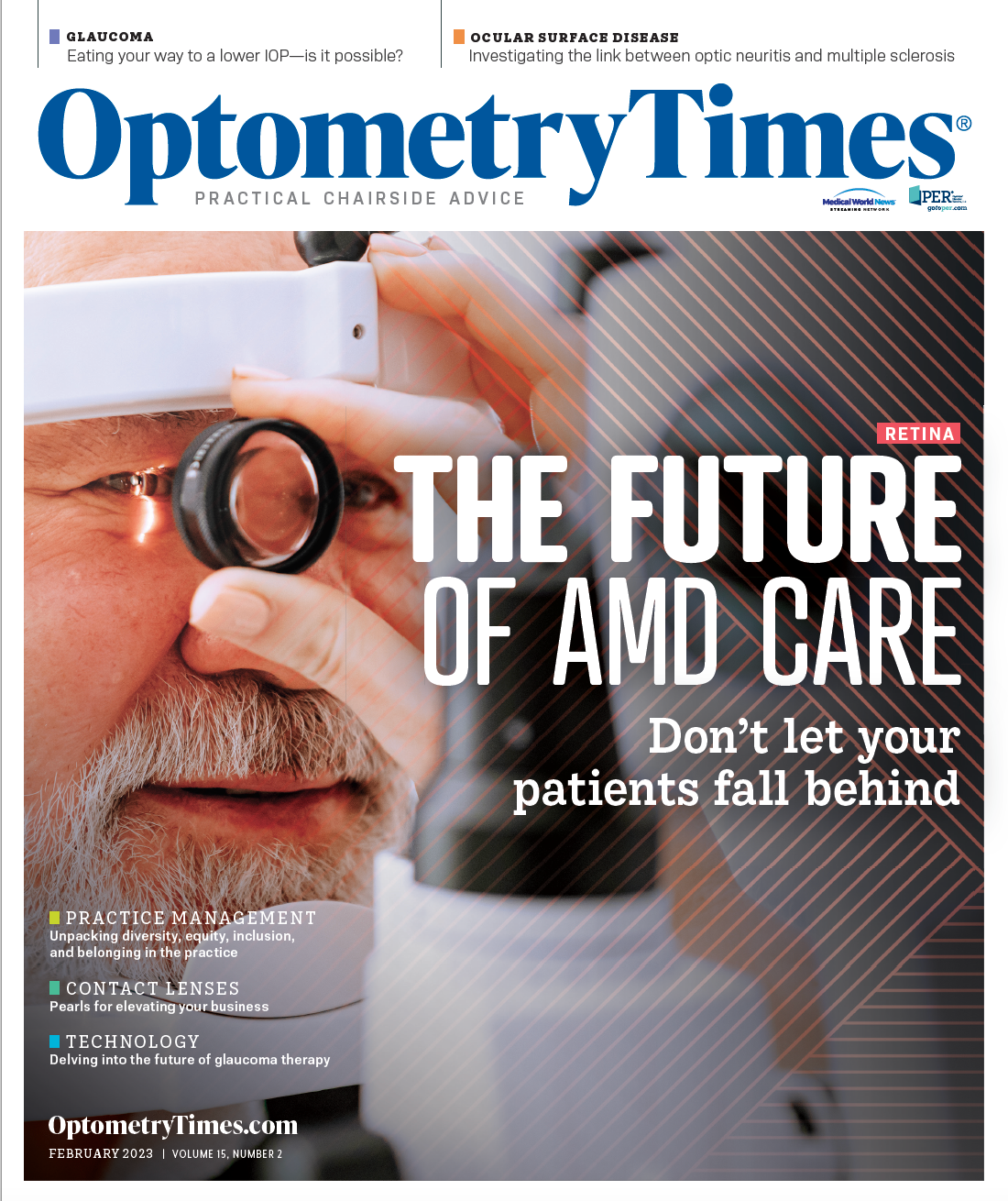Future advances in glaucoma therapy
Medical and surgical technological advances show promise for future glaucoma management.

Glaucoma is a progressive disease that results in damage to the retinal nerve fiber layer and ultimately can cause a measurable loss of functional vision. Because of the irreversible nature of the disease, end-stage glaucoma patients are frequently referred to low-vision services. The rate of glaucoma progression is variable and is generally considered to be correlated with a variety of risk factors.
While the etiology of glaucoma is not well understood, there are several treatment modalities aimed at decreasing intraocular pressure (IOP). Decades of research provide evidence that this is an effective method of mitigating the rate of glaucoma progression and vision loss. Currently, IOP is the only modifiable risk factor and lowering it the only effective strategy for treatment of the disease. The traditional IOP-lowering treatment involves the use of pharmaceutical agents that affect the aqueous outflow pathways and decrease the production of aqueous humor, or a combination of these effects.
Treatment basics
Early and consistent treatment with IOP-lowering medications is standard of treatment for glaucoma patients. Despite our best efforts, there are many barriers to improving adherence to prescribed treatment. Though there are additional barriers, patients often fail to adhere because of forgetfulness, lack of self-efficacy, and difficulties with medication scheduling.1
These 3 barriers are also interrelated. Forgetting to take drops at the prescribed time can lead to patients struggling to keep a consistent schedule. Patients who try to augment their drop regimen because of missed drops can experience significant amounts of stress. Another source of stress is a patient’s inability to instill the drops into their own eyes properly.
Patient education and review of proper drop instillation have become essential components of standard glaucoma follow-up appointments. Patients are quick to opt for drop delivery devices when given the opportunity.2 Another solution for more tech-savvy patients is the use of smartphone apps that set automatic reminders for scheduled dosing.3
Clinicians can be more effective in identifying which patients would benefit from some of these conventional solutions utilizing evidence-based techniques, eg, self-efficacy questionnaires.4
New technologies
New technologies are becoming more popular for treating glaucoma as they can be used to address patient adherence issues. There is a growing number of new devices and drug delivery systems that involve the placement or implantation of drug-releasing materials in the eyelid adnexa and the anterior chamber of the eye, eg, the application of a prostaglandin analog (PGA)-containing vehicle to the periorbital area using a ball-roller device. IOP-lowering effects comparable to traditional drops have been reported.5
While this addresses the barrier to self-efficacy, it does not directly address the patient’s forgetfulness and scheduling difficulties. It seems that inserting a bimatoprost-containing ring into the fornices of the eye, more effectively delivering the PGA (but also having significant mucus buildup as an adverse effect), could be a better solution.6
As an alternative, the OTX-TP is a travoprost-containing intracanalicular insert. The drug-releasing device is placed into the inferior nasolacrimal canaliculus and delivers the drug to the ocular surface via the inferior punctum. Although this could be an effective way of removing the aforementioned barriers, it did not show superior efficacy to traditional drop regimens in phase 2 clinical trials.7
Another slightly more invasive method is the implantation of drug-releasing materials into intracameral space. Durysta, the most successful intracameral implant in clinical trials, received US Food and Drug Administration approval in March 2020. One injection is reportedly effective over a 3- to 4-month period.8 However, the implant itself does not dissolve, and after the device has released its preloaded compounds, it remains in the anterior chamber until it is surgically removed. It should occur to a clinician performing gonioscopy that a visible implant does not necessarily mean a therapeutic drug is being released.
The ENV515 intracameral implant is a biodegradable implant that delivers travoprost.9 Human clinical trials showed effective lowering of IOP for up to 1 year. Updates to the clinical trials in 2017 show that the effect remains robust without significant adverse reactions.10
Implanting a device into the trabecular meshwork has also been considered. In parallel with the advent of iStent for microinvasive glaucoma surgery, the iDose was developed to release travoprost after its implantation in the trabecular meshwork. As with other intraocular implants, the risk of infection and implant migration must be considered. While specific information on the iDose device is not available, there are numerous reports on the iStent device, which is virtually identical and shown to be safe. Like Durysta, however, the iDose device must be replaced once the drug supply has been exhausted.11
Future technology
As we discover more about the etiology of glaucoma, we can develop more novel treatment modalities. One such future technology that shows promise is the use of nanoparticles in the delivery of IOP-lowering drugs.12 Timoptic-XE is a prime example of this technology. It is a pH-sensitive formulation that turns from a solution to a gel when it contacts the tear film and therefore enhances the delivery of the drug to the ocular surface.13
Once we learn more about the disease process of glaucoma itself, we can consider newer surgical technologies, eg, engineered cell–based delivery of ciliary neurotrophic factor (CNTF) and other disease pathway modulations. The delivery of CNTF over a 2-year period by engineered intraocular encapsulated cell technology implants for the treatment of chronic retinal degenerative diseases like age-related macular degeneration, retinitis pigmentosa, and geographic atrophy already exist and have a favorable pharmacokinetic profile without systemic exposure. This treatment could be a long-term treatment modality introduced via intravitreal injection.14
Conclusion
These technologies highlight an exciting future for both medical and surgical glaucoma treatment. However, whether patients would opt for these kinds of treatments is unclear. One survey reports that most patients with glaucoma would still opt for combination of eye drops (85% acceptance) vs microdose eye sprays (54% acceptance), drug-eluting contact lenses (31% acceptance), drug-eluting periocular ring inserts (43% acceptance), or injectable anterior chamber implants (30% acceptance),15 and the authors also report that acceptance of the various treatment modalities differed among subgroups; those with more severe disease were more accepting of new treatment modalities. It remains clear, however, that patient education and collaboration with health care teams (optometrists, ophthalmologists, and other clinicians) must remain as an integral part of glaucoma treatment.
References
1. Newman-Casey PA, Robin AL, Blachley T, et al. The most common barriers to glaucoma medication adherence: a cross-sectional survey. Ophthalmology. 2015;122(7):1308-1316. doi:10.1016/j.ophtha.2015.03.026
2. Sanchez FG, Mansberger SL, Kung Y, et al. Novel eye drop delivery aid preferred over traditional eye drop delivery. Invest Ophthalmol Vis Sci. 2020;61:2663.
3. Trichter C. The 10 best medication reminder apps. onlinedoctor.com. June 30, 2022. accessed August 19, 2022. ttps://www.onlinedoctor.com/best-medicine-reminder-apps/#MediSafe
4. Sleath B, Blalock SJ, Stone JL, et al. Validation of a short version of the glaucoma medication self-efficacy questionnaire. Br J Ophthalmol. 2012;96(2):258-262. doi:10.1136/bjo.2010.199851
5. Woodward DF, Wang JW, Coleman RA, et al. A highly effective and ultra-long-acting anti-glaucoma drug, with a novel periorbital delivery method. J Ocul Pharmacol Ther. 2019;35(5):265-277. doi:10.1089/jop.2018.0126
6. Brandt JD, DuBiner HB, Benza R, et al. Long-term safety and efficacy of a sustained-release bimatoprost ocular ring. Ophthalmology. 2017;124(10):1565-1566. doi:10.1016/j.ophtha.2017.04.022
7. Vantipalli S, Sall KN, Stein E, et al. Evaluation of the safety and efficacy of OTX-TP, an intracanalicular travoprost insert, for the treatment of patients with open-angle glaucoma or ocular hypertension: a phase 3 study. Invest Ophthalmol Vis Sci. 2020;61:3488.
8. Seal JR, Robinson MR, Burke J, Bejanian M, Coote M, Attar M. Intracameral sustained-release bimatoprost implant delivers bimatoprost to target tissues with reduced drug exposure to off-target tissues. J Ocul Pharmacol Ther. 2019;35(1):50-57. doi:10.1089/jop.2018.0067
9. Navratil T, Garcia A, Tully J, et al. Preclinical evaluation of ENV515 (travoprost) intracameral implant - clinical candidate for treatment of glaucoma targeting six-month duration of action. Invest Ophthalmol Vis Sci. 2014;55:3548.
10. Safety and efficacy of ENV515 travoprost extended release (XR) in patients with bilateral ocular hypertension or primary open angle glaucoma. ClinicalTrials.gov. Updated October 17, 2019. accessed August 19, 2022. https://clinicaltrials.gov/ct2/show/results/NCT02371746
11. Dick, H. B., Schultz, T. & Gerste, R. D. Miniaturization in Glaucoma Monitoring and Treatment: A Review of New Technologies That Require a Minimal Surgical Approach. Ophthalmology and Therapy vol. 8 19–30 Preprint at https://doi.org/10.1007/s40123-019-0161-2 (2019)
12. Juliana FR, Kesse S, Boakye-Yiadom KO, Veroniaina H, Wang H, Sun M. Promising approach in the treatment of glaucoma using nanotechnology and nanomedicine-based systems. Molecules. 2019;24(20):3805. doi:10.3390/molecules24203805
13. Weng Y, Liu J, Jin S, Guo W, Liang X, Hu Z. Nanotechnology-based strategies for treatment of ocular disease. Acta Pharm Sin B. 2017;7(3):281-291. doi:10.1016/j.apsb.2016.09.001
14. Kauper K, McGovern C, Sherman S, et al. Two-year intraocular delivery of ciliary neurotrophic factor by encapsulated cell technology implants in patients with chronic retinal degenerative diseases. Invest Ophthalmol Vis Sci. 2012;53(12):7484-7491. doi:10.1167/iovs.12-9970
15. Meier-Gibbons F, Berlin MS, Töteberg-Harms M. Influence of new treatment modalities on adherence in glaucoma. Curr Opin Ophthalmol. 2019;30(2):104-109. doi:10.1097/ICU.0000000000000551

Newsletter
Want more insights like this? Subscribe to Optometry Times and get clinical pearls and practice tips delivered straight to your inbox.